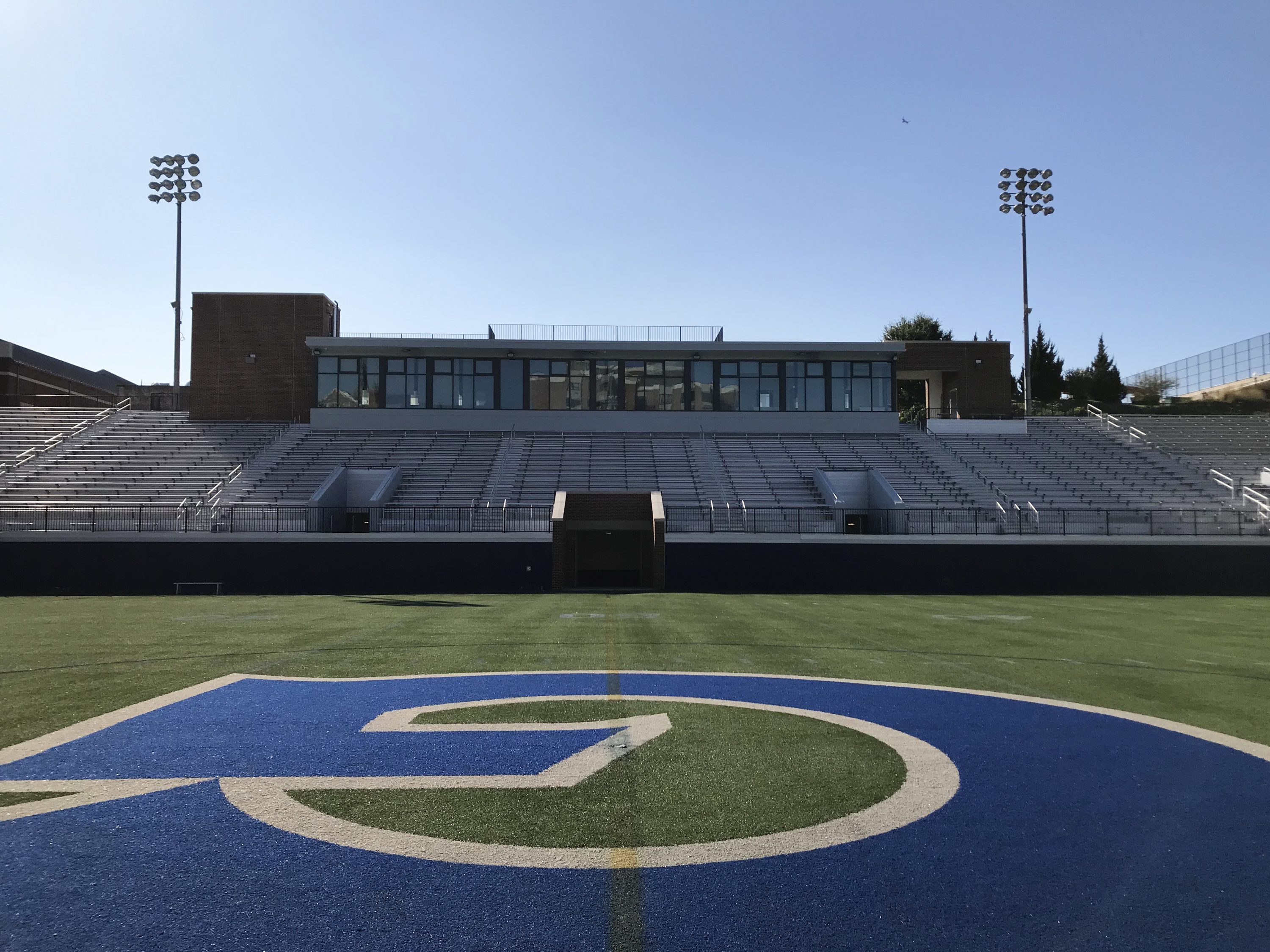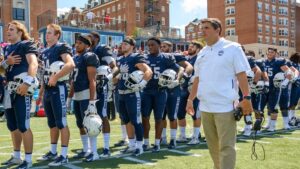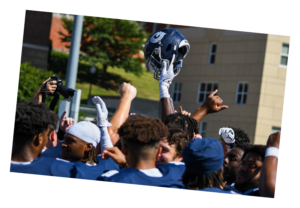On April 30, 2005, University President John DeGioia attended the groundbreaking of Multi-Sport Field alongside a host of alumni, students, and Athletics Department officials. Fifteen years, four months, and 26 days later, the stadium, now known as Cooper Field, looks just about ready to open—and there is almost nobody on campus to see it.
For the greater part of the prior two decades, Georgetown football had a stable, albeit less than ideal, home on the astroturf of Kehoe Field. In 2002, with dwindling attendance and increasing safety concerns, the university decided to close up Kehoe and construct a stadium at the site of the Harbin Field soccer facility.
“[The new stadium] will probably be the most important addition to this campus in the last 50 to 100 years,” said then-head football coach Bob Benson in 2005, just months after breaking ground. With no shortage of pomp and circumstance, administrators courted athletics donors promising that Cooper Field would usher in a new culture and tradition of Georgetown sports. It has not. What went wrong?
While completed stadiums often fail to meet the expectations of their lofty proposals, artists’ depictions of Cooper Field throughout the course of its construction show that neither the Athletics Department nor its architects had a consistent vision for the playing field. A design from 2001 features two-tiered bleachers, while a 2005 proposal presents a stunning glass facade.
These changing models depict the thoughts of a progressively more pragmatic Athletics Department, as VIP suites and lounges gave way to a modest single-tiered design. Yet Georgetown continued to fundraise and recruit for years on the promise of a soon-to-be-opened stadium, even enticing potential donors with the prospect of dedicated seats in their name.
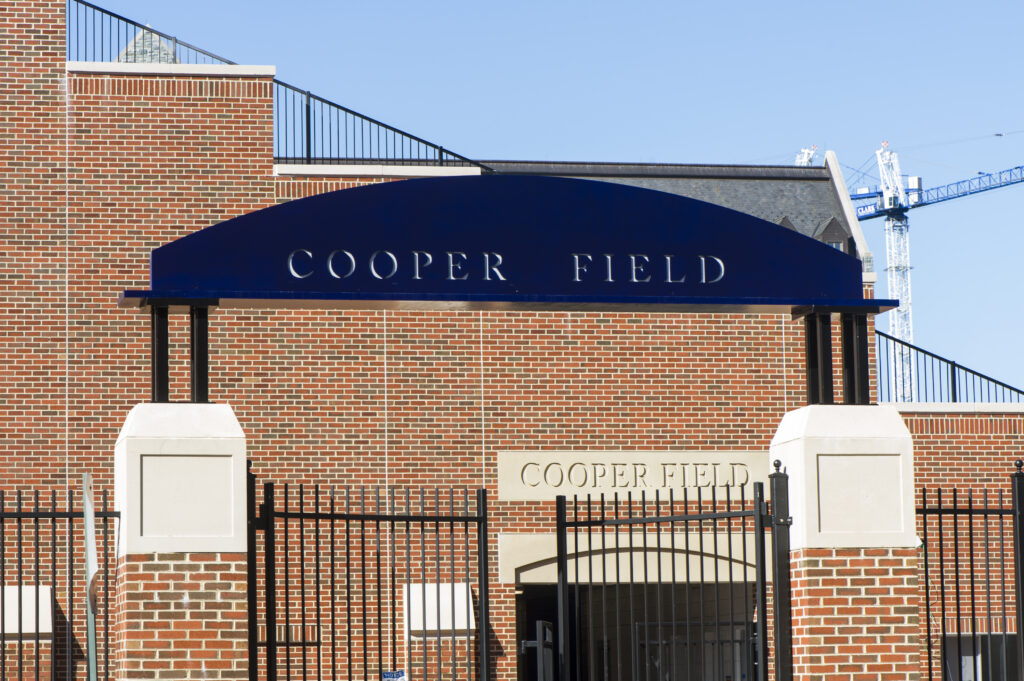
Photo by Abby Webster Cooper Field’s entrance stands tall in the middle of campus.Photo by Abby Webster
Part of the difficulty when it came to finishing the field stemmed from revised priorities. While continuing to float the idea of a new football stadium, the university also felt increasing pressure from athletes, faculty, and donors to improve on-campus facilities. Ultimately, the school prioritized Thompson Athletic Center, which was also subject to years of delays and an inflated $61 million price tag.
“Between 2005 and 2015, in no particular order, you had the Davis Arts Center rebuilt, you had Hariri Hall for the business school, you had Regents Hall for science, you had Arrupe Hall for dormitories,” said John Reagan, the co-founder of HoyaSaxa.com, a site dedicated to Georgetown basketball and football. “There are numerous other conceptual ideas for space on campus that are waiting their turn. In many ways, [Cooper Field] waited its turn.”
Ultimately, the delays on the stadium are a testament to the power of Georgetown’s bureaucracy and the trade-offs that the university must make with its limited budget. Like all other Georgetown-area building projects, the design first had to pass through the Old Georgetown Board, a three-person committee of city-appointed architects infamous for their obstinate approval criteria—according to Reagan, the board once rejected a proposal for the Thompson Athletic Center simply because it had too many windows.
Adding to the complications, Georgetown had to maintain an active playing field at Cooper Field even during construction. Given its proximity to the Southwest Quad, construction crews were also subject to limited working hours.
“There were still games going on, there was still practice going on, and given Georgetown’s lack of extra facilities, they couldn’t just close the entire outfit and do it in nine months,” Reagan said.
The COVID-19 pandemic posed new obstacles for the construction crew, which continued building the stadium even as most students left campus during the pandemic.
With the renovation tangled in bureaucratic inertia and the Athletics Department bogged down by budget constraints, Cooper Field’s temporary bleachers became a monument to the university’s inaction. The stadium seemed more befitting of a small high school than a Division I football program—it featured Porta Potties, memorably uncomfortable seats, and cheap chain-link fencing around its perimeter.
Prior to its renovation, Cooper Field held the ignominious title of being the smallest-capacity stadium in the entirety of Division I football. On game days, athletes had to suit up in McDonough Arena and then make the inconvenient haul to the field in their bulky uniforms.
“It had a temporary feel. It was not very welcoming,” Associate Athletics Director for Internal Operations Dan Trump said. “To be honest, it’s been an eyesore.”
In 2015, ten years after the Multi-Sport Field broke ground, the stadium showed few signs of progress. Then came a $50 million gift from the Cooper family, after whom the field was immediately renamed, which led to a renewed fervor for completing the project.
As the stadium receives its final touches, athletes who have waited three years on campus to see its completion are now relegated to watching from afar as the project comes to fruition. Linebacker Owen Kessler (COL ‘22) told the Voice that football Head Coach Rob Sgarlata recruited him with the promise of a new field. Now Kessler is at home in New Jersey and watching progress on the stadium through videos and pictures that coaches regularly send the team.
“I’m really excited about the new locker room, not only because it’ll be state-of-the-art stuff, but also just its location right under the stands is really cool,” Kessler said.
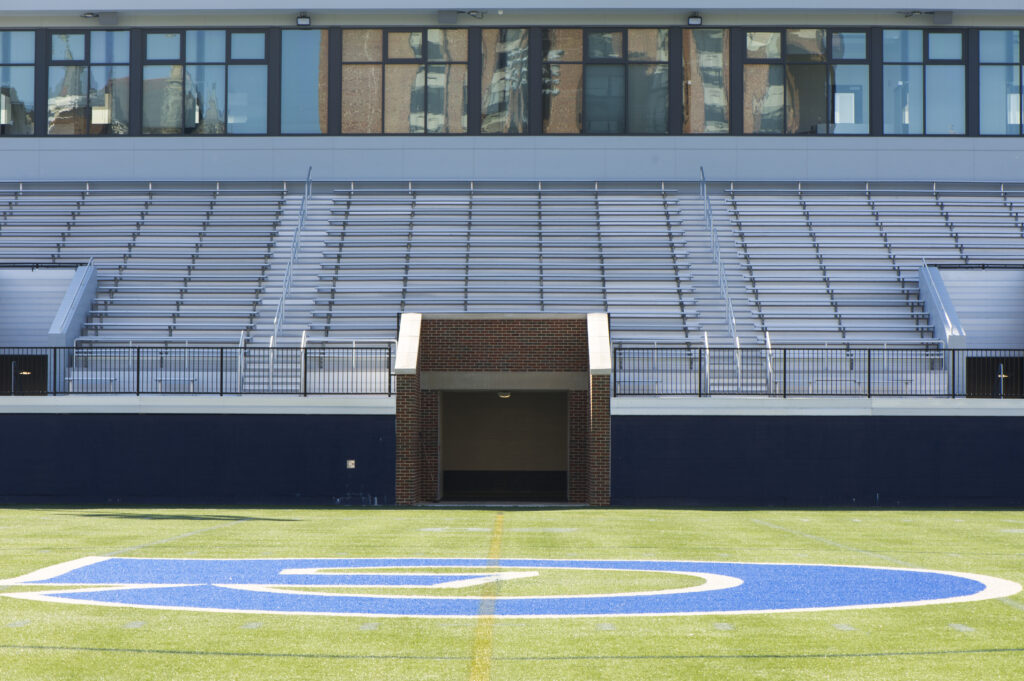
Photo by Abby Webster The brand-new locker room leads directly onto the field.Photo by Abby Webster
The completed Cooper Field also features in-stadium restrooms, food and drink concession stands, a storage facility, and a courtyard with a relocated Jack the Bulldog statue meant for fan photos.
“We’ll be able to get ready for games and then run right out onto the field straight from the locker room, so I think that’ll be awesome,” Kessler said.
The stadium opening will have the most immediate effects on football and field hockey, with Sgarlata writing he was “extremely grateful to the entire Cooper family” and field hockey Head Coach Christy Longacre noting she was “beyond excited” in emailed statements to the Voice. Cooper Field will also have a cascading effect on other sports at Georgetown that previously lacked adequate facilities.
“This is going to open up space for some of our other programs that haven’t had those types of locker rooms,” Trump said. “We’ll be able to accommodate our tennis, golf, sailing, and rowing programs to have actual locker room space that they haven’t really had in the past once football and field hockey are ready to move from their current space out to Cooper.”
The stadium also makes strides towards campus accessibility and sustainability, two greater university goals.
“The new pathway on the east will add campus light poles, and create a path that allows for a universally accessible route to Hariri and Regents Halls,” wrote a university spokesperson in an emailed statement. “As with all construction projects, sustainability was a guiding principle, and we are targeting LEED Silver for the new building.”
Georgetown coaches and administrators are optimistic that the long-awaited stadium will spell multi-generational success for a Georgetown football program that has been mired in mediocrity for years.
“It’s already paid dividends for coaches in terms of the recruiting process,” Trump said.
Georgetown football has long struggled to bring in talent, as evident in its perennial in-conference struggles. The program still refuses to offer scholarships, even as the rest of the Patriot League has warmed up to the idea of using financial aid to attract a more diverse range of players. The team is also subject to the Patriot League Academic Index, which allows the league to monitor recruits’ GPA and test scores in order to ensure Georgetown is admitting only academically-qualified athletes.
Reagan hopes that the stadium will not only aid recruiting at-large, but also help attract D.C. area athletes to the Hilltop. “For those who value the facilities of a university as part of their educational experience, this will help them do a better job of reaching out to the local recruit that has seen the space conditions in the past and chose that it was not for them,” he said. “Georgetown’s lost a lot of local kids over the years.”
Despite all its delays and shortfalls, Cooper Field now stands tall in the center of campus, waiting to one day be filled with spectators and student athletes alike. Though football has long held an uncertain place in Georgetown culture, it finally has a permanent home.
“I think that [the stadium] is a mark that the school will continue to invest in players and I think that’s something incoming players like to see,” said Kessler. “They want a school that’s in full support of their program and they want a school that’s going to invest in their program, so we should have some really strong recruiting classes coming up here in the future.”


